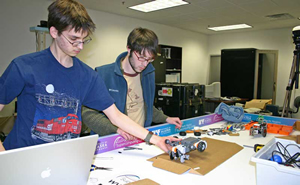Cross-country art demonstrates power of science
Cross-country art demonstrates power of science
Submitted by Stefani Schruf
Phone: 907-450-8677
12/17/07

Download photo
Employees at Rochester Institute of Technology on Tuesday will show New York high school students how to create stunning artwork in Alaska from 4,000 miles away.
Using a Web-based interface, the students will have a chance to operate three remote-controlled devices and two cameras, part of a project developed by students at the Arctic Region Supercomputing Center at the University of Alaska Fairbanks. The demonstration, from 6 to 7 a.m. Alaska Standard Time, will be held in Rochester, N.Y. but others are welcome to attend the demonstration online by visiting www.arsc.edu/science/remotecontroldevice/howto.phtml
The interface allows users to operate the devices from virtually anywhere on the planet using text- or audio-based applications. During the Tuesday demonstration, the devices will be outfitted with felt-tipped markers to draw the students’ artistic creations. The devices can also complete tasks such as moving objects and overcoming an array of obstacles on a 4- by 8-foot project board.
ARSC research projects assistant and UAF computer science student Devin Jones developed the remote-control device project under the guidance of ARSC systems analyst Paul Mercer. Mercer says that while the project is comparable to a video game, "this is real because there are concrete repercussions for errors and irresponsible behavior." According to Mercer, this type of project has the potential to be used in military operations, scientific exploration, roving development, collaborative problem solving, cooperative endeavors, entertainment and other uses yet to be discovered.
The project has its roots in early experiments Jones conducted with AGDeviceControl, a program that allows users to remotely control presentation tools over The Access Grid, a large-scale high-speed collaborative environment.
Today, the entire project operates on a 4- by-8 foot, bilevel board with two Sony cameras that stream live images of the three robots. Two Parallax Boe-Bot robots, named OLD and NEW, pick up and move objects while a Lego NXT2 device, called NXT, is configured as a forklift. Mercer says that users who have operated the devices have commented that the experience is comparable to driver’s training for Mars Exploration rover operators.
For information on using the Web-based interface, visit the project’s website at www.arsc.edu/science/remotecontroldevice/index.phtm.
CONTACT: Paul Mercer, systems analyst, at 907-450-8649 or via e-mail at mercer@arsc.edu; Devin Jones, research projects assistant, via e-mail at djones@arsc.edu; Debra Damron, communications group leader, at 907-450-8662 or via e-mail at damron@arsc.edu; or Stefani Schruf, ARSC media student, at 907-450-8677 or via e-mail at schruf@arsc.edu.


